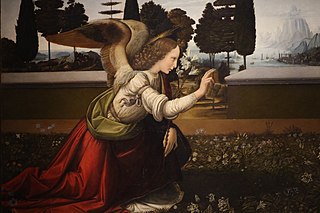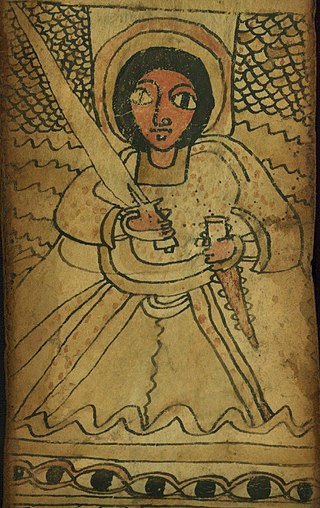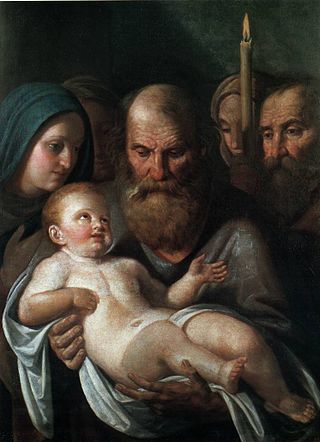Annas was appointed by the Roman legate Quirinius as the first High Priest of the newly formed Roman province of Judaea in AD 6 – just after the Romans had deposed Archelaus, Ethnarch of Judaea, thereby putting Judaea directly under Roman rule.

In the Abrahamic religions, Gabriel is an archangel with the power to announce God's will to mankind. He is mentioned in the Hebrew Bible, the New Testament, the Quran and the Kitáb-i-Aqdas. Many Christian traditions – including Eastern Orthodoxy, Catholicism, Lutheranism, and Anglicanism – revere Gabriel as a saint.

Archangels are the second-lowest rank of angel in the Christian hierarchy of angels, put forward by Pseudo-Dionysius the Areopagite in the 5th or 6th century in his book De Coelesti Hierarchia. However, they are the highest rank to interact directly with humans, seraphim and the like remaining close to God.

Joseph ben Caiaphas was the High Priest of Israel during the years of Jesus' ministry, according to Josephus. In the New Testament, the Gospels of Matthew, Luke and John indicate he was an organizer of the plot to kill Jesus. He famously presided over the Sanhedrin trial of Jesus. The primary sources for Caiaphas' life are the New Testament, and the writings of Josephus. The latter records he was made high priest by the Roman procurator Valerius Gratus after Simon ben Camithus had been deposed.

Uriel, Auriel or Oriel is the name of one of the archangels who is mentioned in the post-exilic rabbinic tradition and in certain Christian traditions. He is well known in the Russian Orthodox tradition and in folk Catholicism and recognised in the Anglican Church as the fourth archangel. He is also well known in European esoteric medieval literature. Uriel is also known as a master of knowledge and archangel of wisdom.

Anna, distinguished as Anna the Prophetess, is a woman mentioned in the Gospel of Luke. According to that Gospel, she was an elderly woman of the Tribe of Asher who prophesied about Jesus at the Temple of Jerusalem. She appears in Luke 2:36–38 during the presentation of Jesus at the Temple.
Clopas is a figure of early Christianity. The name appears in the New Testament, specifically in John 19:25:
Near the cross of Jesus stood his mother, his mother's sister, Mary the wife of Clopas, and Mary Magdalene.
Theophilus is the name or honorary title of the person to whom the Gospel of Luke and the Acts of the Apostles are addressed. It is thought that both works were written by the same author, and often argued that the two books were originally a single unified work. Both were written in a refined Koine Greek, and the name Θεόφιλος (Theophilos), as it appears therein, means friend of God or (be)loved by God or loving God in the Greek language. The true identity of Theophilus is unknown, with several conjectures and traditions around an identity. In English Theophilus is also written "Theophilos", both a common name and an honorary title among the learned (academic) Romans and Jews of the era. The life of Theophilus would coincide with the writing of Luke and the author of the Acts.

Phanuel is the name given to the fourth angel who stands before God in the Book of Enoch, after the angels Michael, Raphael, and Gabriel. Other spellings of Phanuel include Panuel,Paniel, Peniel, Penuel, Fanuel, and Feniel. As Panuel, his name means "God has turned", but as Paniel, his name means "The face of God".

Luke 1 is the first chapter of the Gospel of Luke in the New Testament of the Christian Bible. With 80 verses, it is one of the longest chapters in the New Testament. This chapter describes the birth of John the Baptist and the events leading up to the birth of Jesus. Two canticles, the canticle of Mary and the canticle of Zechariah, are both contained within this chapter. The unnamed author of Luke names its recipient, Theophilus, who is most likely a real person, but the term could simply mean a fellow believer, since theophilus is Greek for God lover. Early Christian tradition uniformly affirms that Luke composed this Gospel as well as the Acts of the Apostles, the companion volume to Luke, which is addressed to Theophilus in the same way. The title "The Gospel of Luke", found in many Bibles and some manuscripts, was added later with no indication that it was originally part of the text.

Luke 2 is the second chapter of the Gospel of Luke in the New Testament, traditionally attributed to Luke the Evangelist, a companion of Paul the Apostle on his missionary journeys. It contains an account of Jesus's birth in Bethlehem, "its announcement and celebration", his presentation in the Second Temple, and an incident from his childhood. Verses 1–14 are often read during services of worship on Christmas Day.
Ramiel is a fallen Watcher angel. He is mentioned in Chapter 6 of the apocryphal Book of Enoch as one of the 20 Watchers that sinned and rebelled against God by mating with human women, and creating offspring called Nephilim.

The Angel of the Lord is an entity appearing repeatedly in the Hebrew Bible on behalf of the God of Israel.

Simeon at the Temple is the "just and devout" man of Jerusalem who, according to Luke 2:25–35, met Mary, Joseph, and Jesus as they entered the Temple to fulfill the requirements of the Law of Moses on the 40th day from Jesus' birth, i.e. the presentation of Jesus at the Temple.

Luke 24 is the twenty-fourth and final chapter of the Gospel of Luke in the New Testament of the Christian Bible. The book containing this chapter is anonymous, but early Christian tradition uniformly affirmed that Luke the Evangelist composed this Gospel as well as the Acts of the Apostles. This chapter records the discovery of the resurrection of Jesus Christ, his appearances to his disciples and his ascension into heaven.

Luke 8 is the eighth chapter of the Gospel of Luke in the New Testament of the Christian Bible. The book containing this chapter is anonymous but early Christian tradition uniformly affirmed that Luke the Evangelist, a companion of Paul the Apostle on his missionary journeys, composed both this Gospel and the Acts of the Apostles. This chapter mentions the women who supported Jesus and records some of the great miracles he performed, as well as several parables told by him.

Luke 9 is the ninth chapter of the Gospel of Luke in the New Testament of the Christian Bible. It records the sending of the twelve disciples, several great miracles performed by Jesus, the story of his transfiguration, Peter's confession and the final departure from Galilee towards Jerusalem. Scottish minister William Robertson Nicoll describes this chapter as unfolding "sundry particulars which together form the closing scenes of the Galilean ministry". The book containing this chapter is anonymous, but early Christian tradition uniformly affirmed that Luke the Evangelist composed this Gospel as well as the Acts of the Apostles.
In some Christian traditions, the Angel of the Presence / Face or Angel of his presence / face refers to an entity variously considered angelic or else identified with God himself.
Raguel also known as Akrasiel, Raguil, Raquel, Rakul and Reuel, is an angel mainly of the Judaic traditions. He is considered an Angel of Justice. His name means "God shall pasture". This meaning is also related to the Hebrew word "rōʿī" (רֹעִי), meaning shepherd.

The mocking of Jesus occurred several times, after his trial and before his crucifixion according to the canonical gospels of the New Testament. It is considered part of the passion of Jesus.













